But I cannot find enough documented information about exactly when these last three children of Ezekiel Calhoun were born to allow me to assign very precise birthdates to them. As the posting linked above indicates, it appears to me Patrick was born between 1752 and 1755, following his sister Catherine Calhoun Noble, who was born about 1752, I think.
Ezekiel Colhoun, Son of Ezekiel Calhoun and Jean/Jane Ewing
The posting linked in the first paragraph above also tells you that I find various accounts of the family of Ezekiel Calhoun and Jean/Jane Ewing assigning their son Ezekiel Calhoun a birthdate of 12 February 1756, but in none of these accounts have I found a source cited to document that date of birth.[1] This birthdate for Ezekiel is certainly possible, and it fits what I’ve discovered about the birth order of the children of Ezekiel Calhoun and Jean/Jane Ewing. It would be helpful, however, wouldn’t it, to have information about the source of this birthdate?
In a thread about this Ezekiel Calhoun started in July 2000 at the Genealogy.com surname board for the name Calhoun, a number of posters mention a book published by Katherine Dunning Calhoun in 2000, with the title And Here They Stayed: A History of the Calhouns of Western North Carolina.[2] I have been unable to find a copy of this book, which is listed in WorldCat’s catalogue. It was apparently privately published by Katherine Dunning Calhoun and is said to focus on a John Calhoun whose father was Ezekiel Calhoun, son of Ezekiel Calhoun and Jean/Jane Ewing. Perhaps this source contains more information about Ezekiel Calhoun, including documented information about his birthdate.
I have also not found documentation of a spouse and date of marriage assigned to Ezekiel in various published accounts of this family, which state that he married Permelia Fricks in Augusta County, Virginia, on 3 February 1776.[3] In his scant account of Ezekiel Calhoun in his book 800 Years of Colquhoun, Colhoun, Calhoun, and Cahoon Family History, Orval O. Calhoun states that among the few pieces of information he had found about Ezekiel was that he had a wife named Mellie.[4] Some researchers have taken the lead provided by Orval Calhoun to claim that Ezekiel married Permelia Fricks in Augusta County, Virginia, in 1776, though it’s not clear to me how someone whose family lived in Abbeville County, South Carolina, would have found a spouse in Augusta County, Virginia, many miles north of Abbeville County, even if the Calhoun family did live in that Virginia county prior to its relocation to South Carolina in February 1756.[5]
I can by no means claim that I’ve done exhaustive research about Ezekiel, son of Ezekiel Calhoun and Jean/Jane Ewing, but I can say that from the research I’ve done thus far, I have not found documents naming his wife. The 1800 federal census shows Ezekiel in Abbeville County aged 26-44 with a wife in the same age range and four females under 10 in the household, along with one enslaved person.[6] In 1810, Ezekiel (listed on this census as Ezekiel Colhoun Junr) is again aged 26-44 with a wife in the same age category. His household now has three males under 10, three females 10-15, and a female 16-25, with three enslaved persons.[7] On both censuses, Ezekiel’s first cousin Ezekiel Calhoun (1770-1817), son of William Calhoun and Agnes Long, who is often confused with the Ezekiel Colhoun who was son of Ezekiel Calhoun and Jean/Jane Ewing, is listed near known members of the William Calhoun family. The Ezekiel Colhoun who is son of Ezekiel Calhoun and Jean/Jane Ewing appears on both the 1800 and 1810 censuses close to Richard Posey. As a previous posting has noted, Richard Posey was a neighbor of Benjamin Green, who was, in my view, likely the father of John Green who married Jane Kerr, a daughter of Ezekiel Calhoun and Jean Ewing’s daughter Mary and husband Samuel Kerr.
As what I’ve just written suggests, Ezekiel, son of Ezekiel Calhoun and Jean/Jane Ewing, used the Colhoun spelling of his surname, as his brother John Ewing Colhoun did. I’ve found several documents signed by Ezekiel, consistently with the Colhoun spelling of his name.

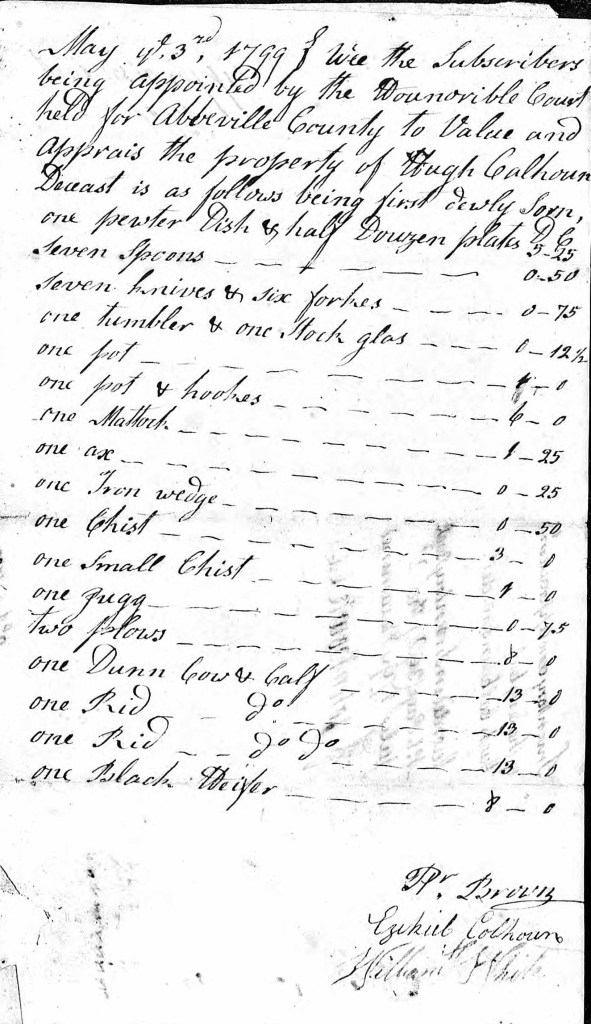

The first set of these documents showing Ezekiel signing himself as Ezekiel Colhoun are in the loose-papers estate file of Hugh Calhoun in Abbeville County (box 18, pkg. 287). Hugh Calhoun died testate in Abbeville County prior to 25 March 1799, when an order was given for the inventory of his estate; his will is dated 25 August 1794, and the original is in the estate file. The order to inventory appoints Ezekiel Calhoun Junr among others to appraise the estate. The inventory was done on 3 May 1799 and signed by Peter Brown, Ezekiel Colhoun, and William White. The same three men signed a return of the inventory to court on the same day.
The signature of Ezekiel Colhoun on these 1799 documents is the same signature as the Ezekiel Colhoun signing a number of documents I’ll discuss below. And the fact that the order to inventory Hugh Calhoun’s estate calls this Ezekiel Junr enables us to identify this Ezekiel Colhoun as the Ezekiel Colhoun designated as Ezekiel Colhoun Junr on the 1810 federal census in Abbeville County. Note, too, the names Joseph Calhoun and Peter Brown in these estate records in which Ezekiel Colhoun is mentioned: they will recur in documents cited below. I am assuming, without having proven this, that Ezekiel Colhoun, son of Ezekiel Calhoun and Jean/Jane Ewing, is called junior in Abbeville County documents of this period because the Ezekiel Calhoun who was son of Hugh Calhoun and is named in Hugh’s will was older than the son of Ezekiel and Jean Ewing Calhoun.

On 13 March 1804 in Abbeville County, Ezekiel Colhoun gave bond with Thomas Finley for Ezekiel’s guardianship of Sarah Brown Pettigrew, John McLane Pettigrew, and Ebenezer Pettigrew.[8] The bond shows Ezekiel signing his name as Ezekiel Colhoun. The equity court case file in which this bond is found shows that in January 1814, John McLane Pettigrew filed suit against Ezekiel Calhoun as guardian of the minor children of Ebenezer Pettigrew Sr. John M. Pettigrew’s complaint states that after Ebenezer died, Thomas Finley married Ebenezer’s widow Sarah and Ezekiel was made guardian of the minor Pettigrew children, and alleges that Ezekiel had not accounted for his use of the estate. Estate documents show that Sarah had died by 5 March 1804 and Ezekiel Calhoun and Stephen Gibert were summoned to court to show cause why lands belonging to Sarah’s estate should not be allotted to Thomas Finley as her widower. They saw no cause that this land allotment should not be made, and the court appointed Joseph Calhoun, Andrew Weed, Peter Brown, and Peter Gibert to divide the lands. By March 1805 when the land division was made, Ebenezer and Sarah Pettigrew’s daughter Sarah Brown Pettigrew had married Stephen Gibert. The couple had married 4 June 1804.
On 2 February 1815, Ezekiel Colhoun responded to the complaint filed by John M. Pettigrew. Ezekiel’s response says that before marrying Ebenezer Pettigrew, Sarah had first married an unnamed Stedman, by whom she had a son James Stedman. Ezekiel notes that the division of land in Sarah’s estate when she died had ignored her son James Stedman. As we’ll see in a moment, when the John Stedman who married Ezekiel’s sister Jane Calhoun died in Abbeville County prior to 28 August 1797, administration of his estate was given to James Stedman. Lewin Dwinnell McPherson identifies this James Stedman as John’s son.[9] Sarah, wife of Ebenezer Pettigrew, is thought to have been the Sarah McLean who married James Stedman in St. Philip’s parish in Charleston on 30 November 1779.
The James Stedman who was Sarah McLean’s husband prior to her marriage to Ebenezer Pettigrew would, it seems, have been related to the John Stedman who married Jean/Jane Calhoun. Were these two men brothers? The James Stedman administering John Stedman’s estate was not, it should be noted, the James Stedman whom Sarah McLean married in 1779. Sarah’s husband James Stedman had died prior to her marriage to Ebenezer Pettigrew on 30 July 1782.[10] James Stedman and Sarah McLean’s son James Stedman would have been born between 1779-1782.
Further documents from this case of John M. Pettigrew vs. Ezekiel Calhoun found in a separate file in Abbeville County equity court records show an audited account for Ezekiel’s expenditures as guardian of the Pettigrew minors in the period from September 1806 to 1810 was audited.[11]
Another Abbeville equity court case file contains extensive documents some of which have information about Ezekiel Colhoun. The case, Trustees of Estate of John de la Howe vs. Dr. Moses Waddel, concerns a will made by Dr. John de la Howe prior to his death on 2 January 1797.[12] De la Howe’s will placed his personal estate in trust in the hands of the South Carolina Agricultural Society and made Peter Gibert and William Hutton executors. On de la Howe’s death, the executors wrote a letter to the Society advising it of the terms of the will.
On 14 December 1805, an act of the South Carolina legislature appointed Colonel Joseph Calhoun, Peter Gibert, Andrew Norris, Moses Waddel, and Ezekiel Colhoun trustees to carry into effect the terms of de la Howe’s will,[13] and on 30-31 December 1806 the trustees sold the residue of the personal estate of de la Howe. Note the interconnections between these men: Joseph Calhoun (1750-1817) was Ezekiel Colhoun’s first cousin, son of William Calhoun and Agnes Long. Andrew Norris was Ezekiel’s half-brother, son of Robert Norris and Jean/Jane Calhoun. Moses Waddel’s first wife Catherine Calhoun was another first cousin of Ezekiel, the daughter of Patrick Calhoun and Martha Caldwell. Peter Gibert was the father of the Stephen Gibert who married Sarah Brown Pettigrew, Ezekiel Colhoun’s ward.

On 15 September 1807 Moses Waddel, Joseph Calhoun, Andrew Norris, and Ezekiel Colhoun signed a statement settling part of the estate of John de la Howe with Peter Gibert as executor. The signed statement is in this case file and shows Ezekiel signing his name as Ezl. Colhoun.
On 30 April 1830, Moses Waddel answered the complaint of the plaintiffs who were alleging that Moses had mishandled funds of Dr. de la Howe. Moses Waddel’s answer to the complaint states that from Dr. de la Howe’s death in January 1797 to December 1806, the estate was in the hands of and under management of the Agricultural Society and Peter Gibert. Moses Waddel’s well-documented answer to the complaint of the litigators contains a valuable piece of information about Ezekiel Colhoun: it states that Ezekiel Colhoun resigned as a trustee in December 1816 and soon after died. Note that this date syncs with the 25 January 1817 death date for Ezekiel given in the same accounts of his family which also state that he was born 12 February 1756.[14]

I find one other document in Abbeville County equity court case files showing that Ezekiel, son of Ezekiel Calhoun and Jean/Jane Ewing, used the Colhoun spelling of the family surname. In the 1809 case of Bickley and Clark vs. Andrew Norris, Ezekiel Colhoun, and Benjamin Howard, which involved a dispute over enslaved persons Jenny and her son Prince purchased in 1806 by Ezekiel for the use of Polly Howard, wife of Hamilton Wilson, Ezekiel signed his 12 June 1809 response to Joseph Bickley’s complaint as Ezl. Colhoun.[15]
These notes represent the extent of what I can, with my present resources, document with certainty about Ezekiel Colhoun, son of Ezekiel Calhoun and Jean/Jane Ewing. I am very dubious about the claim that he married a wife (as I note above, she’s identified as Permelia Fricks by those making this claim) in Augusta County, Virginia, in February 1776. I haven’t found a record naming Ezekiel Colhoun’s wife, nor a record showing the names of his children. This is not to say that those records don’t exist, but merely to underscore that I haven’t yet unearthed them.
Jane Calhoun, Daughter of Ezekiel Calhoun and Jean/Jane Ewing
Regarding Ezekiel Calhoun and Jean/Jane Ewing’s last daughter, Jean/Jane (I’ll call her Jane Calhoun from here on out, for simplicity’s sake), I have been unable to find almost any documentation at all. As a previous posting notes, in his series of articles in South Carolina Historical and Genealogical Magazine on the Calhoun family of South Carolina, A.S. Salley states that Jane was the last child of Ezekiel and Jean/Jane Ewing Calhoun, and that she married John Steadman.[16] Salley provides no further information about Jane.
As the posting I’ve just linked also notes, numerous family trees and published pieces assign Jane a birthdate of 1743 – the birthdate of her oldest sister Mary Calhoun Kerr – but provide no evidence whatsoever to support that birthdate for Jane Calhoun Stedman (this is the usual spelling of her married surname that I find in various records). As John Lisle has noted, “Much has been published about these families [i.e., Stedman families in South Carolina], and much of it is wrong.”[17] For instance, in his genealogical folders about the Calhoun family, researcher Leonardo Andrea cites notes stating that Jane Calhoun married John Steedham or Stedman in 1760, and that John died in 1797 and is buried in Lexington County, South Carolina.[18] McPherson also has Jane Calhoun marrying John Stedman in 1760, and assigns the couple a set of children I find in no records, who began to be born in 1762.[19]
As we’ll see in a moment, the John Stedman who married Jane Calhoun died in Abbeville County prior to 28 August 1797. Lexington County is over 80 miles southeast of Abbeville County. It’s highly unlikely that John Stedman would have been buried in the Lexington County when it’s clear he died in Abbeville County. The notes Andrea is citing appear to be confusing the John Stedman who married Jane Calhoun and lived in Abbeville County with a John Steedman who came to South Carolina, evidently from Scotland, at some point prior to 1762 and died in Lexington County in 1795.[20] Because of the erroneous link of John and Jane Calhoun Stedman to Lexington County, many family trees and published works provide this couple with a family of children in Lexington County who belong to an entirely different family than that of John and Jane.
Citing no documentation to support his claim, Orval O. Calhoun states that John Stedman was born in 1743 – and this, I think, may be the source for the persistent claim, equally undocumented, that John’s wife Jane Calhoun was born in 1743.[21] About Jane Calhoun Stedman, I have found no solid information at all. About her husband John Stedman, I find information that places him in the Long Cane settlement of what would later be Abbeville County by April 1772, and which links him closely to Jane Calhoun’s older brother John Ewing Colhoun.

On 23 April 1772, Patrick Calhoun (uncle of Jane Calhoun Stedman) surveyed 100 acres for John Stedman in the Long Cane settlement of Granville County, South Carolina.[22] The surname is given as Steadman here. This tract was bordered on the west corner by William Calhoun (Jane Calhoun’s uncle) and was vacant on all other sides. The grant for this land was made 30 October 1772 and a memorial was recorded 22 January 1773.[23] Note that this survey record suggests that John Stedman was born by 1754.
When a memorial was made for Cornelius Brown’s 150 acres in the Long Cane settlement on 8 August 1774, it noted that Brown’s tract bordered William Calhoun, James Pettigrew, and John Steadman.[24] Note the Pettigrew surname, which we met in discussing Jane Calhoun Stedman’s brother Ezekiel and which we’ll keep encountering in records pertaining to John Stedman.
By 27 November 1779, John Stedman begins appearing in records in connection to Jane Calhoun’s brother John Ewing Colhoun: on that date, William McKinley and wife Mary sold John Ewing Colhoun and John Stedman, all of the Long Cane settlement in Ninety-Six District, 100 acres on the northwest fork of Long Cane, now called Little River, at a place called the Shoals.[25] This land appears to have had considerable value, since John E. Colhoun and John Stedman bought it for £3,250. As we’ll see in a moment, an act of the South Carolina legislature on 7 March 1789, speaks of fish dams on Little River from its entrance to the Savannah up to John Stedman’s mill. In addition, as we’ll also see, when Patrick Calhoun surveyed 640 acres for John Stedman on the northwest fork of Long Cane (i.e., Little River) on 6 September 1784, he noted in his survey book that this land was at John Stedman’s mill place on the northwest fork of Long Cane.
John Stedman operated a mill at the Shoals on Little River, I conclude, and, in buying his initial 100 acres on the Shoals with John E. Colhoun on 27 November 1779, he may have been purchasing a mill already established on the land. The conveyance record speaks of appurtenances on the tract at the time Colhoun and Stedman bought it.
The conveyance record also states that the land bought by Colhoun and Stedman was bordered on the north by land owned by Robert Turnbull. According to Eugene Trimble, Turnbull is a variant spelling of the surname Trimble, and Robert Turnbull was a Robert Trimble who married William McKinley’s sister Esther. Another sister, Sarah McKinley, married Patrick Calhoun, son of James Calhoun and Susanna Long. Eugene Trimble also states that Robert Turnbull’s/Trimble’s sons John and Joseph married sisters Jane and Mary Stedman, who were daughters of John Stedman and Jane Calhoun.[26] Patrick Calhoun’s survey of the 100-acre tract at the Shoals for William McKinley, dated 7 June 1765, shows the land on the west side of the northwest fork of Long Cane (later, Little River), and indicates that Robert Turnbull’s land bordered this tract on the northwest.[27]
I have not found a Revolutionary record for John Stedman. A South Carolina Revolutionary audited account file for a man with this name (file 7331) is, it seems clear to me, a file for a John Stedman who lived in Chester County and served in the Turkey Creek regiment under Captains John Steel and George Neely. This is not the John Stedman who married Jane Calhoun.
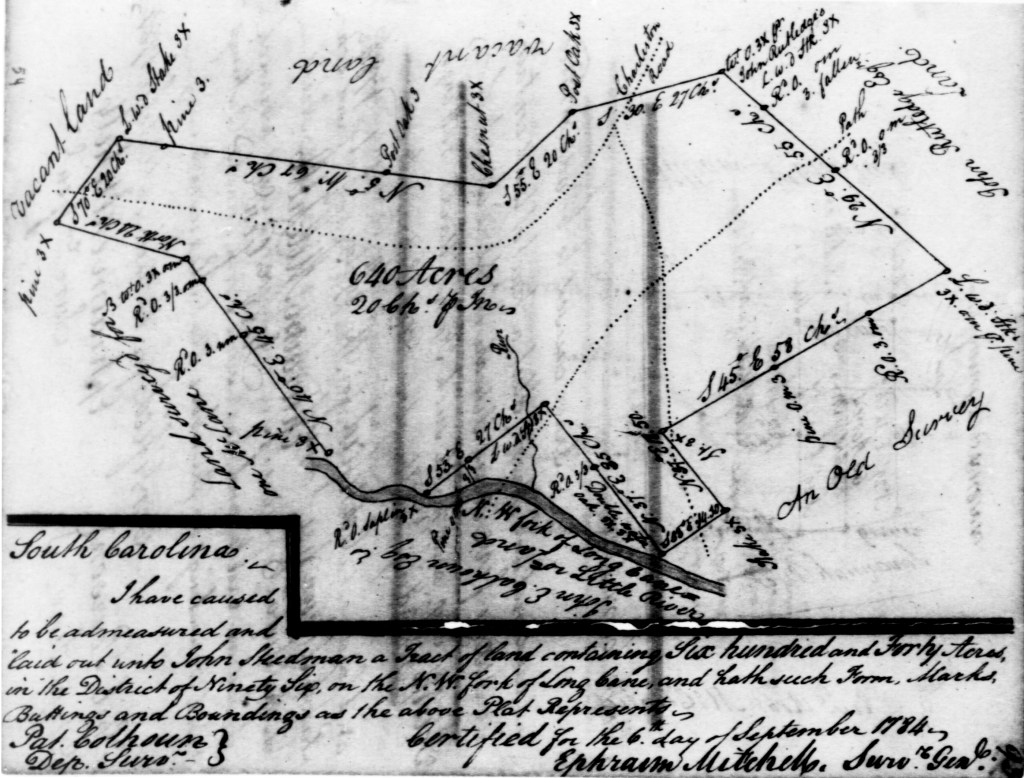

As I noted above, on 6 September 1784, Patrick Calhoun surveyed 640 acres for John Stedman on the northwest fork of Long Cane (i.e., Little River).[28] In a small survey book he kept in the period 1784-1792, Patrick Calhoun noted that the 640 acres were at John Stedman’s mill place on the northwest fork of Long Cane.[29] This entry in the survey book indicaates that John Stedman already had a mill established on Little River (as the northwest fork of Long Cane came to be known) by 6 September 1784. The plat shows the 640 acres bordering land on the west side of the northwest fork of Long Cane which is marked as “John E. Colhoun Esq.” and which, I think, is the 100-acre tract John E. Colhoun and John Stedman jointly purchased from William McKinley on 27 November 1779 which, as I explain above, likely contained the mill John Stedman was operating by September 1784 and probably earlier.


On 8 April 1785, Patrick Calhoun surveyed two more tracts of land on the northwest fork of Long Cane in Ninety-Six District for John Ewing Colhoun and John Stedman. One tract was 150 acres that appears to border the 100-acre tract I take to be John Stedman’s mill tract.[30] The other tract was 900 acres with this plat showing a path running through the tract from the northwest fork of Long Cane to Sawney’s (here, Sanes’) Creek. Just below the intersection of this path and the fork of the Long Cane, the plat shows the 100-acre tract originally patented to William McKinley that John E. Colhoun and John Stedman bought in November 1779.[31] Bordering that McKinley (later, Colhoun-Stedman) tract on the east is land labeled as Widow Turnbull’s land.

Both of these surveys are in Patrick Calhoun’s survey book for the same date, which notes that the 900 acres included John Rutledge’s old survey for 850 acres between Little River and Jones Creek, and that the 150 acres adjoined John Stedman’s and John E. Colhoun’s other lands.[32]
A plat Patrick Calhoun made for James Noble, a cousin of John E. Colhoun and of John Stedman’s wife Jane Calhoun, on 20 June 1785 for 250 acres on Sawney’s Creek shows the tract bordered on the west by Samuel Brown and by land owned jointly by John Ewing Colhoun and John Stedman.[33] Another plat that Thomas Finley made for Ebenezer Pettigrew on 20 June 1785 for 156 acres on Little River shows Pettigrew’s land bordered south by John Stedman’s land.[34] This is the Ebenezer Pettigrew discussed previously, who married Sarah McLean, widow of James Stedman, on 30 July 1782, and for whose minor children John Stedman’s brother-in-law Ezekiel Colhoun assumed guardianship after Ebenezer died before 21 March 1795 and his widow Sarah then married Thomas Finley.
Ebenezer Pettigrew’s loose-papers estate file in Abbeville County shows Sarah giving bond with Joseph Calhoun and Benjamin Howard in the amount of £2,000 sterling on 21 March 1795 for estate administration.[35] And on 27 March 1795, John Pettigrew gave an additional bond of $4,000 on behalf of Sarah as the widow and estate administrator. It appears that Sarah married Thomas Finley prior to 7 November 1797 when he gave bond with John Quay and William Dunlap for his administration of the estate along with Sarah as the widow.[36]
Note that the Benjamin Howard giving bond with Joseph Calhoun in March 1795 with Sarah McLean Pettigrew for her administration of Ebenezer’s estate is the same Benjamin Howard we’ve met previously, in the 1809 case of Bickley and Clark vs. Andrew Norris, Ezekiel Colhoun, and Benjamin Howard. A survey that Thomas Finley did for Benjamin Howard on 15 May 1793 for 250 acres on Calhoun Creek in Ninety-Six District shows this land bordered on its east side by Ebenezer Pettigrew.[37]
The Pettigrew family was intermarried with the Gibert family whom we’ve also encountered in the preceding notes about Ezekiel Colhoun. As noted above, a daughter of Ebenezer Pettigrew and Sarah McLean, Sarah Brown Pettigrew, married Stephen Gibert on 4 June 1804, while Ezekiel Colhoun was her guardian. Stephen Gibert was a son of Pierre/Peter Gibert (abt. 1755-1815), a Huguenot settler of the Long Cane who moved from the Languedoc province of France to London in 1770 and then to South Carolina in 1772. Peter Gibert represented the Abbeville District in the South Carolina General Assembly from 1807 to 1812.[38]
Pierre Gibert was the nephew of Jean Louis Gibert (1722-1773), who led a Huguenot colony from France to New Bordeaux in what would later be Abbeville County in 1764. Pierre succeeded his uncle Jean Louis as pastor of a church that Jean Louis Gibert founded at New Bordeaux when he established the colony.[39] A daughter of Jean Louis Gibert, Louise Gibert, married William Pettigrew, a brother of Ebenezer Pettigrew. Thomas Finley, who married Sarah McLean Pettigrew after Ebenezer died, had previously married Jeanne Gibert, another of Louis Gibert’s daughters.[40]
A South Carolina legislative committee report dated 20 January 1789 shows John Stedman and Andrew Roper petitioning the state legislature along with other inhabitants of the Long Cane and Little River to protest the obstruction of the passage of fish by mill dams on these streams.[41] In response to this petition, on 7 March 1789, the South Carolina legislature enacted an ordinance authorizing Patrick Calhoun, John de la Howe, and Peter Gibert to assure that all proprietors of mill dams on Little River from its entrance to the Savannah up to John Stedman’s mill and across Long Cane Creek from its confluence with Little River to Andrew Ross’s mill allow passage wide enough in each dam to permit fish to pass through.[42]
John Stedman is enumerated on the 1790 federal census in Abbeville County with a household in which there are three males over 16 and three females.[43] Six houses prior to John Stedman’s household is Ebenezer Pettigrew’s family, and two houses after John is the family of James Tannehill (Tawnihill here) who, as we’ll see in a moment, gave bond with James Stedman for James’ administration of John Stedman’s estate.
Notes I made some years back as I read material in the John Ewing Calhoun Papers held by the South Caroliniana library at University of South Carolina, Columbia, state that these papers include an inventory of John Stedman’s goods made by Samuel Brown on 23 April 1793. If I copied the date of the inventory correctly, then this inventory would apparently not have been made following John’s death, but for some other purpose, since, as we’ll see shortly, John Stedman seems to have died before 28 August 1797, and his estate was inventoried on 11 November 1797 by Joseph and John Trimble and Peter Brown. If nothing else, the fact that John E. Colhoun had this listing of the goods of his brother-in-law John Stedman confirms what we learn from other documents – i.e., that John E. Colhoun and John Stedman were closely connected.
A 27 November 1794 plat by William Wardlaw for William Berry for 307 acres on Messers Creek, a branch of Little River in Ninety-Six District, shows land owned jointly by John E. Colhoun and John Stedman bordering this tract on the north.[44] Another plat made on 23 November 1799 by Peter Gibert for Duke Beale for 172 acres on Sawney’s Creek shows the land bordered on north by land laid out to Peter Brown and John Stedman. Sawney’s Creek runs through the south part of the tract.[45] And on 10 December 1799, John Trimble surveyed 30 acres for Jonathan Wood on branches of Sawney’s Creek, with the plat showing the land bordered on the north by Joseph Calhoun and on the west by John Stedman.[46]
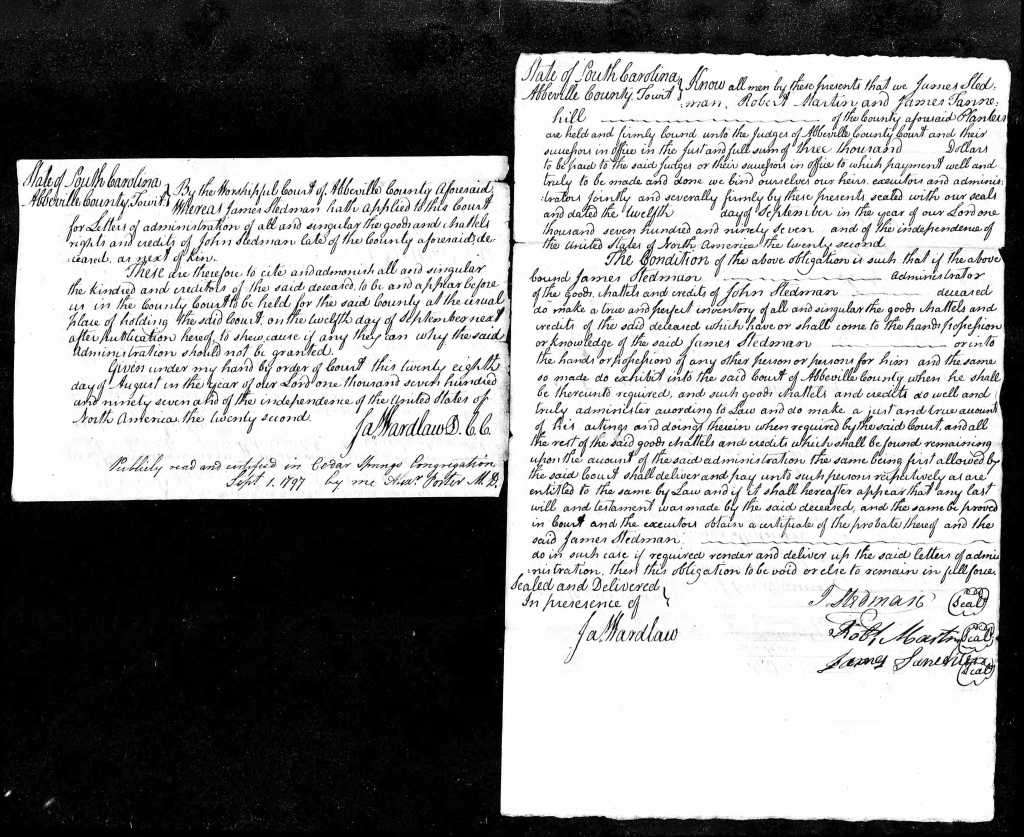

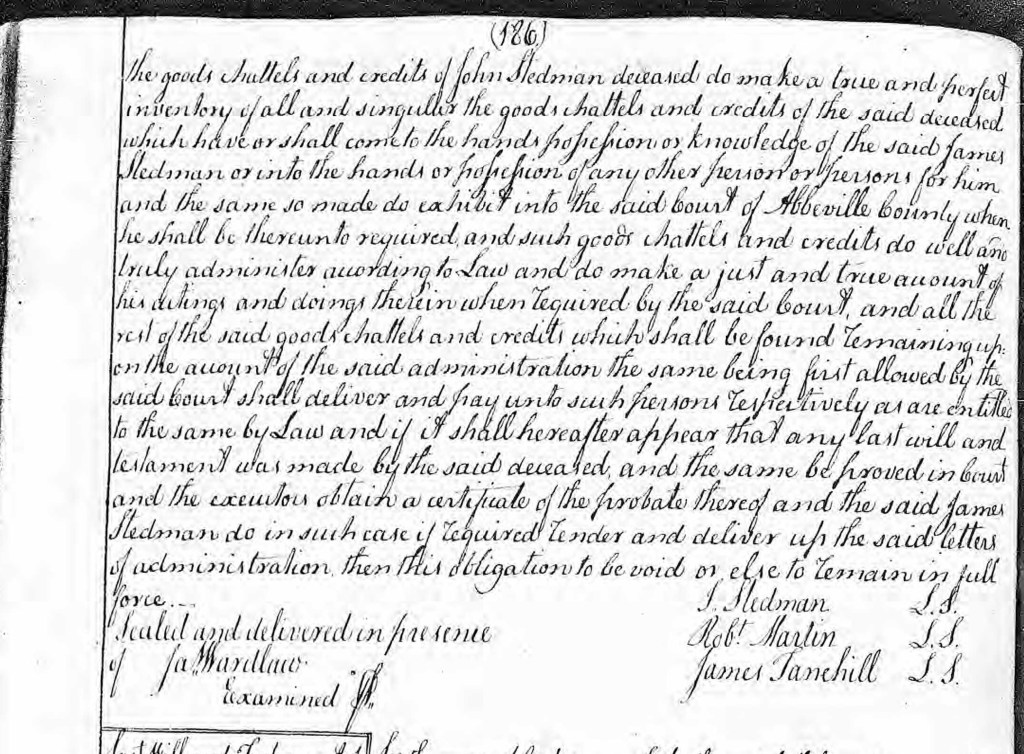
John Stedman’s loose-papers estate file in Abbeville County shows that he had died by the time these two surveys were made in 1799. The estate papers show that James Wardlaw ordered publication of the intent of James Stedman to probate John Stedman’s estate on 28 August 1797, and this intent was published at Cedar Springs Presbyterian church on 1 September. James Stedman gave a $3,000 bond on 12 September 1797 for administration of John’s estate, with bondsmen Robert Martin and James Tannehill.[47] Cedar Springs was an offshoot of the Lower Long Cane Presbyterian church and is today on the borders of Abbeville and Greenwood Counties in the Cedar Springs Historic District about halfway between Abbeville and Troy.



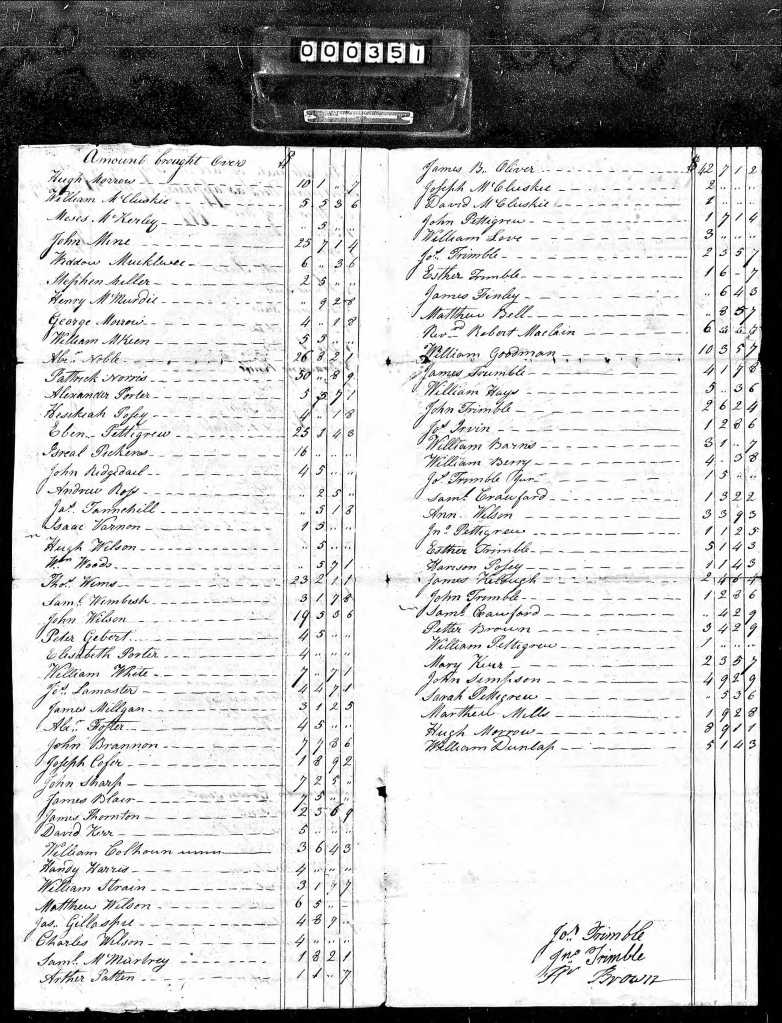
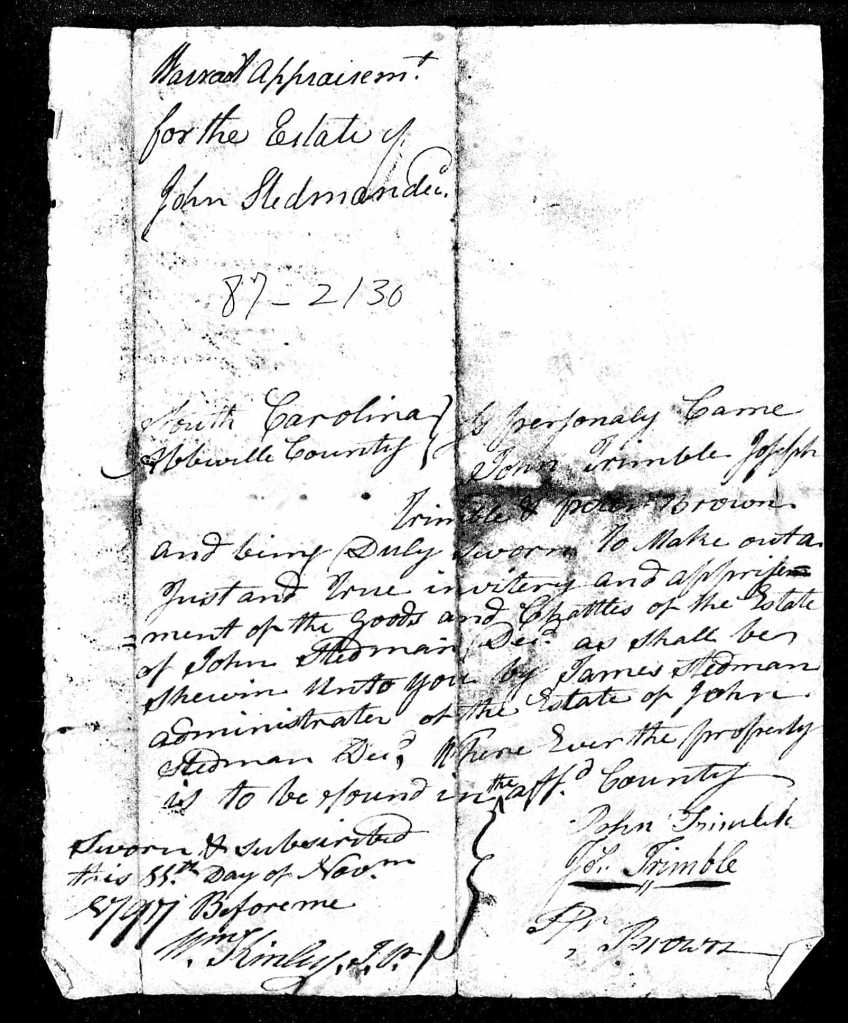
On 11 November 1797, John Stedman’s estate was inventoried and appraised by Joseph and John Trimble and Peter Brown. Among the notes listed as owed to the estate were two notes owed by Mary Kerr, sister of John’s wife Jane Calhoun Stedman, for $3.64 and $2.35. There was also a note on Benjamin Green Sr., who was, in my view, father of the John Green who married Jane Kerr’s daughter Jane, for $2.46. Others owing notes to the estate included Patrick Norris, Ebenezer Pettigrew, Israel Pickens, Peter Gibert, David Kerr, William Calhoun, Reverend Robert McLain, John Simpson, and William and Sarah Pettigrew.
No documents in the estate file mention John Stedman’s wife Jane Calhoun, and there is no mention of the children of John Stedman and Jane Calhoun. I think it’s likely that Jane predeceased John. As I’ve noted previously, I also seriously doubt the claim of some researchers that Jane was born in 1743. I think she was the last daughter of Ezekiel Calhoun and Jean/Jane Ewing and was likely born between 1755 and September 1759, when Ezekiel made his will.
I may be wildly wrong in doubting that there’s proof Ezekiel Colhoun married Permelia Fricks in Augusta County, Virginia, and in doubting the list of children often assigned to that couple. And I may be wrong in doubting that Jane Calhoun was born in 1743 and in doubting the long list of children assigned to her and John Stedman. I’ll gladly revise my conclusions if someone can point me to documents – and perhaps they’re there and I just haven’t found them – which prove the name of Ezekiel’s spouse and the names of their children, and the date of Jane’s birth and the names of her children. So far, I’ve found no documentation of these matters, and would love to have someone show some good documentation to me on these points, if it does exist.
[1] See e.g. “Calhoun Profile,” a document that appears to have been compiled by David Garrison, a pastor of Bethel Presbyterian church at Walhalla, Oconee County, South Carolina. The 12 February 1756 birthdate is also assigned to Ezekiel Calhoun at his FamilySearch Tree page, with no source cited to document this birthdate.
[2] This thread beings with Judy T. Murphy’s posting, “Ezekiel CALHOUN Jr Abbeville SC.” For mention of Katherine Dunning Calhoun’s book And Here They Stayed: A History of the Calhouns of Western North Carolina, see Bobby Calhoon’s reply to Judy Murphy on 23 December 2000.
[3] See e.g. the FamilySearch Tree page for Permelia Fricks.
[4] Orval O. Calhoun, 800 Years of Colquhoun, Colhoun, Calhoun, and Cahoon Family History (Baltimore: Gateway Press, 1976), p. 175.
[5] See the interchange on Genealogy.com’s Calhoun surname thread between Bobby Calhoon and Judy T. Murphy in August 2001 in which Bobby Calhoon tells Judy Murphy that she is fast becoming the authority on Permelia Fricks as the Mellie mentioned by Orval Calhoun, and in which he asks for the source of this information, and Judy Murphy tells him she would email him in response to his question.
[6] 1800 federal census, Abbeville County, p. 33B.
[7] 1810 federal census, Abbeville County, South Carolina, p. 6.
[8] Abbeville County, South Carolina, Equity Court Files box 68, pkg. 3472.
[9] Lewin Dwinnell McPherson, Calhoun, Hamilton, Baskin and Related Families (priv. publ., 1957), p. 50.
[10] But note the James Steadman found on the 1790 federal census in St. Philip’s and St. Michael’s Parishes, Charleston County, South Carolina (p. 278): Who is he?
[11] Abbeville County, South Carolina, Equity Court Files box 42, pkg. 2311.
[12] Abbeville County, South Carolina, Equity Court Files box 64, pkg. 3353.
[13] See The Statutes at Large of South Carolina: Containing the acts from 1786, exclusive, to 1814, inclusive, arranged chronologically (Columbia: Johnson, 1839), p. 495.
[14] See supra, n. 1.
[15] Abbeville County, South Carolina, Equity Court Files box 64, pkg. 3473.
[16] A.S. Salley, “The Calhoun Family of South Carolina (Continued),” South Carolina Historical and Genealogical Magazine 7,3 (July 1906), p. 153.
[17] John Lisle, “Stedmans in Colonial America,” Stedman Family Organization website.
[18] Calhoun family folder no. 129, p. 10, Leonardo Andrea Collection.
[19] McPherson, Calhoun, Hamilton, Baskin and Related Families, pp. 49-50.
[20] See Lisle, “Stedmans in Colonial America.”
[21] Orval O. Calhoun, 800 Years of Colquhoun, Colhoun, Calhoun, and Cahoon Family History (Baltimore: Gateway, 1976), p. 174.
[22] South Carolina Colonial Plats Bk. 21, p. 2.
[23] South Carolina Colonial Land Grants Bk. 27, p. 154; South Carolina Memorials Bk. 12, p. 5.
[24] South Carolina Memorials Bk. 12, p. 539.
[25] South Carolina Register of Mesne Conveyance Bk. 5C, pp. 70-3.
[26] Trimble Families: A Partial Listing of the Descendants of Some Colonial Families (priv. publ., Kensington, Maryland, 1958; revised 1997), pp. 10-12.
[27] South Carolina Colonial Plat Bk. 8, p. 390.
[28] South Carolina Plats Charleston Series Bk. 10, p. 93.
[29] Patrick Calhoun’s survey book (1784-1792) is in Clemson University library’s Special Collections and Archives, “John C. Calhoun Papers,” mss. 200.
[30] South Carolina Plats Charleston Series Bk. 7, p. 160.
[31] Ibid., Bk. 9, p. 27.
[32] See Patrick Calhoun’s survey book (1784-1792), Clemson University library’s Special Collections and Archives, “John C. Calhoun Papers,” mss. 200.
[33] South Carolina Plats Charleston Series Bk. 15, p. 299.
[34] Ibid., Bk. 17, p. 244.
[35] Abbeville County, South Carolina, Loose-Papers Estate Files, box 109, pkg. 3086.
[36] For further notes on the Pettigrew family, see Penelope Johnson Allen, “Leaves from the Pettigrew Family Tree,” at Hank Birdsong’s Birdsong family website.
[37] South Carolina Plats Charleston Series Bk. 29, p. 309.
[38] See N. Louise Bailey, ed., Biographical Directory of the South Carolina House of Representatives, vol. 4: 1791-1815 (Columbia: University of South Carolina Press, 1974), pp. 229–230.
[39] William Caine Moragne, An Address Delivered at New Bordeaux, Abbeville District, S.C., November 15, 1854 on the 90th Anniversary of the Arrival of the French Protestants at that Place (Charleston: Phynney, 1857), p. 47. See also D. Huger Bacot, “The South Carolina Up Country at the End of the Eighteenth Century,” American Historical Review 28,4 (July 1923), p. 695, citing Howe, Presbyterian Church in S. C., I. 352-356. Bacot erroneously speaks of Pierre Gibert and not his uncle Jean Louis Gibert as founder of the New Bordeaux colony.
[40] Moragne, An Address Delivered at New Bordeaux.
[41] South Carolina legislative committee report, “Committee Report on the Petition of Inhabitants of Long Cane and Little River, Protesting the Obstruction of the Passage of Fish by Mill Dams” (20 January 1789).
[42] The Statutes at Large of South Carolina: Containing the Acts from 1786, Exclusive, to 1814, inclusive, Arranged Chronologically (Columbia: Johnson 1839), no. 1449, p. 103.
[43] 1790 federal census, Abbeville County, South Carolina, p. 452.
[44] South Carolina Plats Charleston Series Bk. 32 p. 245.
[45] South Carolina Plats Columbia Series Bk. 37, p. 420.
[46] Ibid. Bk. 38, p. 579.
[47] Abbeville County, South Carolina, Loose-Papers Estate Files box 87, pkg. 2130; and Abbeville County, South Carolina, Will Bk. 1, pp. 185-6.
3 thoughts on “Children of Ezekiel Calhoun and Jean/Jane Ewing: Ezekiel Colhoun and Jane Calhoun Stedman”